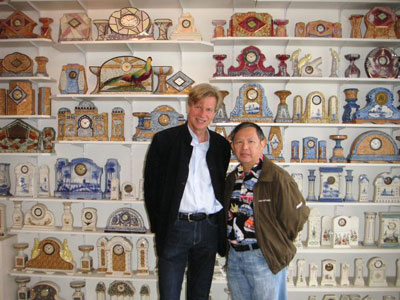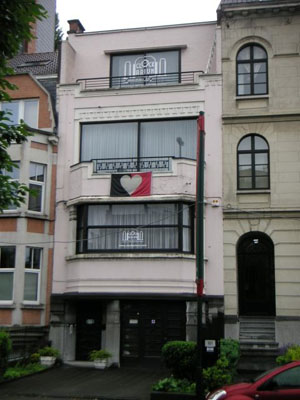Finding faience in Brussels
This article appears on page 46 of the January 2013 issue.
by Sandy Fox; Scottsdale, AZ
Jacques de Selliers, owner of almost 4,000 faience clocks, welcomes people from all over Europe to his Clockarium Museum (163 boulevard Reyers; phone +32 475 55 20 26) in the heart of Brussels, Belgium. Housed in a delightful 1935 converted residence, the collection is full of ceramic mantel clocks of many colors and designs, from elephants and cats to pyramids and Chinese scenery.
A tour of time
As my husband, Lawrence, and I entered the 3-story Art Deco building, we were given an introduction to the clocks and how they were made. Selliers’ collection is made up of “faience fine” clocks, made from white clay decorated with lead glaze (as opposed to the tin-glazed faience ware named for the Italian town of Faenza).
Selliers has more than 1,300 of the 4,000 pieces on display. His passion for and knowledge of his collection were evident.
“I love the variety and the inventiveness of my clocks,” said Selliers, “and I so enjoy showing them to others.”
Tours are usually given in French, but he does speak English very well, so if there are groups of 10 or more English-speaking visitors, he will do the tour in English. I was very lucky that on the windy, rainy day that we went, we were the only ones in attendance, so we were able to get a private tour in English.
“If everyone speaks English and it’s not 10 or more, that is okay also,” he added, “but if one person speaks French, then it becomes a French-speaking tour.”
A bit of history
Selliers fell in love with this type of clock and began collecting them in the early ’90s wherever they could be found — in flea markets, antique shops and secondhand stores. The museum was opened in 1999.
The faience clock was the poor man’s clock, made with cheap mechanisms from Germany and decorated to imitate the real marble of the clocks that decorated the fireplace mantels of the rich. As these clocks became more and more popular, bigger and better ones came on the market.
A craze was born, giving rise to millions of ceramic clocks being produced in a huge variety of shapes, styles and decorations.
The first floor of the museum is devoted to Czech clocks, decorated with delicate, stencil-applied decorations, and French clocks, mostly in the Art Deco style.
The second floor features Belgian clocks of all possible styles, though they favor geometrical patterns and bold colors.
The third floor is for Art Deco clocks of various origins: German, Dutch, Austrian and Italian. There is also a room devoted to decadent clocks dating from the ’50s to the present.
Selliers also had examples of molds that some of the clock forms were made from and explained the production process to us.
Most who enter the museum notice that all the clocks are set to exactly the same time: 10:10. Selliers explained that this is because the raised position of the hour and minute hands, similar to what our arms would look like if raised, is simply thought to be more positive.
“Think of the clock arms at 4:40, both pointing downward; it is a much more discouraging sign,” he said. “Thinking positively is the way to look at it.”
The details
Tours of the museum (€6 per person) are given only on Sunday afternoons at 3:05 p.m. Appointments are not required, but you should check online to be sure that the museum will be open. Private group tours can be arranged.
There is no elevator, so it would be difficult for those with limited mobility to climb the stairs.
It was a wonderful 1½-hour tour that we thought was one of the highlights of our trip to Brussels.


